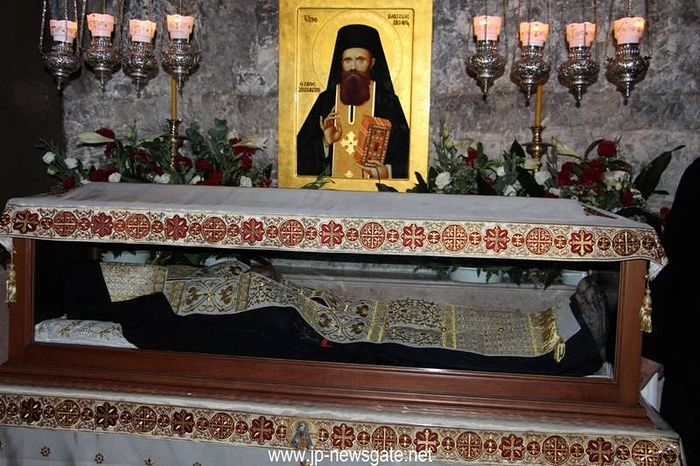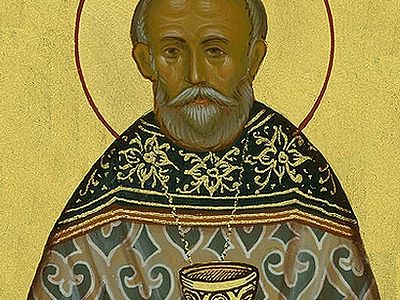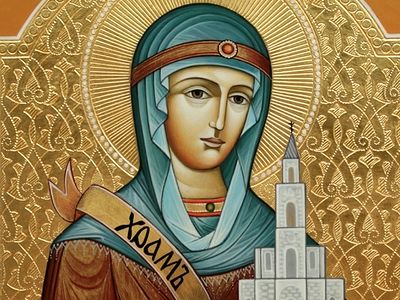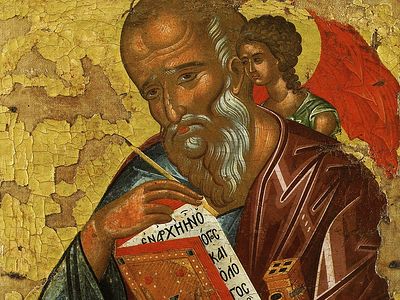Source: Jerusalem Patriarchate
January 29, 2016
On Sunday January 18/31, 2016, the ceremony of the canonization of St. John the Hozebite by the Patriarchate of Jerusalem took place at the Monastery of Sts. George and John the Hozebites.
During the Divine Liturgy, His Beatitude Patriarch Theophilos of Jerusalem, read the Canonization decree, as follows:
SYNODICAL ACT OF CANONIZATION
OF ST. JOHN THE HOZEBITE
The area of the Cherith brook and the Monastery of St. George Hozebite within it, the place where we hold today this joint Patriarchal Liturgy, have proven to be sites of revelation of God’s miracles for the salvation of man since the days of the Old Testament. This is where, to escape the wrath of king Ahab, Prophet Elias sought refuge, called by God: Get thee hence, and turn thee eastward, and hide thyself by the brook Cherith, that is before Jordan. And it shall be, that thou shalt drink of the brook; and I have commanded the ravens to feed thee there. (1 Kings 17:2-4). In the same area, Joshua asked God to make the sun stand still over Gibeon and the moon over the Valley of Aijalon, so the sun stood still and the moon stopped (Joshua 10:12-13).
In the early years of the New Testament, the holy and righteous Joachim and Anna prayed here and became ancestors of God as by divine intervention they were liberated from the shame of childlessness and bore a child, Mary the Ever-Virgin, through whom the Only Begotten Son and Logos of God, Jesus Christ, became incarnate by the Holy Spirit.
During the first years of the monastic angelic community, shown to us by our Lord Jesus Christ, this area was inhabited by the five venerable fathers of the monastery of Hozeba: Promos, Elias, Yannaios, Aian and Zenon, who led a holy life of sanctification.
After them, in the fifth century AD, St. John, bishop of Caesarea, Palestine, an opponent of the heresy of Monophysitism, expanded this first skete into a large monastic centre. Then, men, churches and cells were lost to the Persian rage in 614 AD. From the ruins and the ashes of destruction, St. George the Hozebite, hailing from Cyprus, went on to restore the monastery and turn it once more into a pole of attraction and a monastic centre for hundreds of monks.
[…]
In the mid-twentieth century God blessed the monastery par excellence through the presence of His chosen vessel, St John the Hozebite. Leaving behind his earthly homeland of Romania, relatives and friends, he arrived in the Holy Land as a pilgrim and received the monastic schema at the Monastery of St Savva the Sanctified, where he would live a monk’s life for a decade. He then went on to lead an ascetic life at this Monastery of Hozeba, hence why he has been called “the Hozebite.” He also lived in the desert of the Jordan river, emulating the example of the Baptist and subjecting himself to asceticism, fasting, vigilance and prayer ... Those who knew St. John attest to this day of his holy life and the help he offered through prayer and spiritual guidance. Others attest that after his dormition they were cured of their illnesses by his mediation.
For these reasons, and for the strengthening of the faithful of the Mother of Churches and those pilgrims who have come to the Monastery of Hozeba from across the world, and to the glory of our Triune God, the Holy and Sacred Synod has decided to sanctify St. John the New Hozebite and place him in the canon of Saints of the Church of Jerusalem, his memory to be observed on the twenty-eighth of July of each year, the day of the translation of his holy relics.
In the Holy City of Jerusalem, December 22, 2015
THEOPHILOS III Patriarch of Jerusalem
KYRIAKOS Metropolitan of Nazareth
ISYCHIOS Metropolitan of Kapitolias, Patriarchal Commissioner
CHRISTODOULOS Metropolitan of Eleutheroupolis, Elder Dragoman
BENEDICT Metropolitan of Philadelphia
DOROTHEOS Archbishop of Avila
ARISTARCHOS Archbishop of Constantina, Elder Secretary-General
METHODIOS Archbishop of Tabor
THEOPHYLAKTOS Archbishop of Jordan
DEMETRIOS Archbishop of Ledda, Secretary of the Holy and Sacred Synod
PHILOUMENOS Archbishop of Pella
Archimandrite Nektarios, Elder Kamarasis
Archimandrite Ioustinos
Archimandrite Theodoritos
Archimandrite Hilarion
Archimandrite Timotheos
Archimandrite Evdokimos
Archimandrite Galaktion




